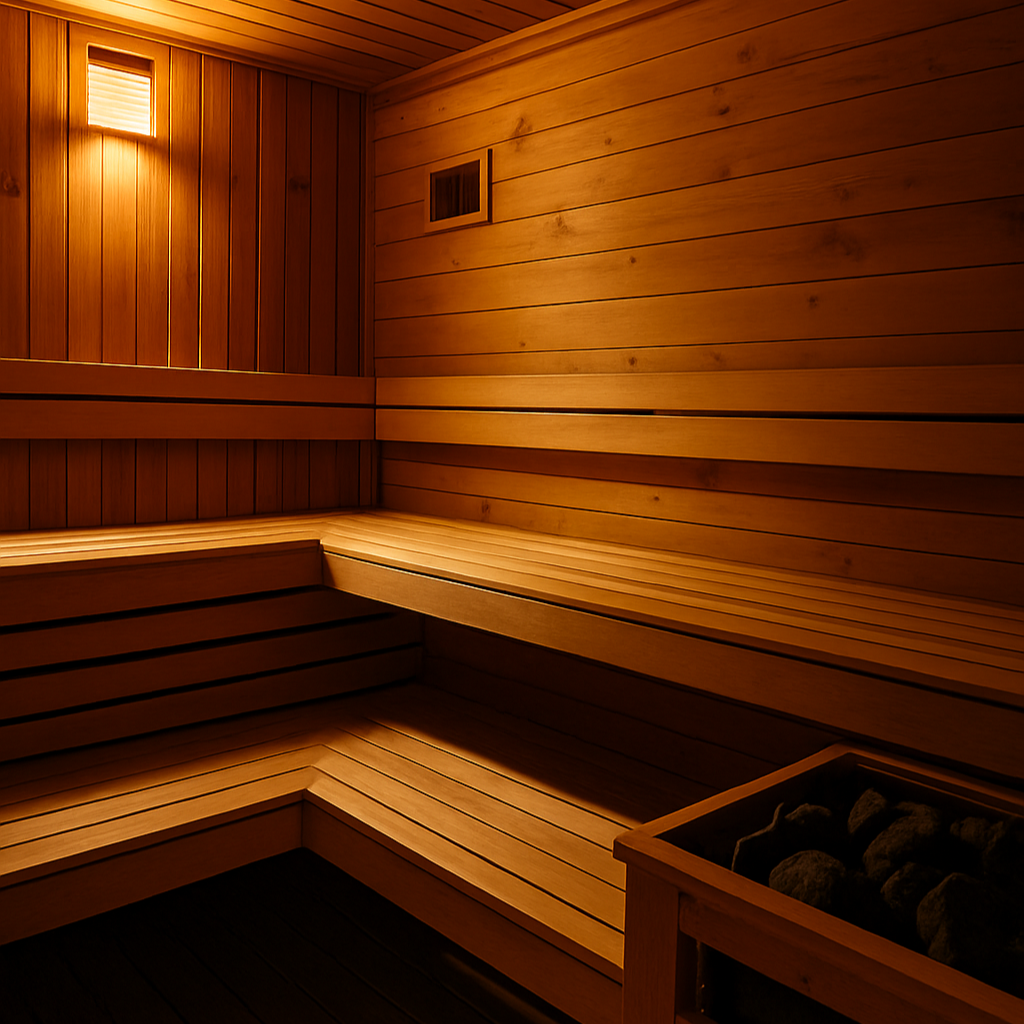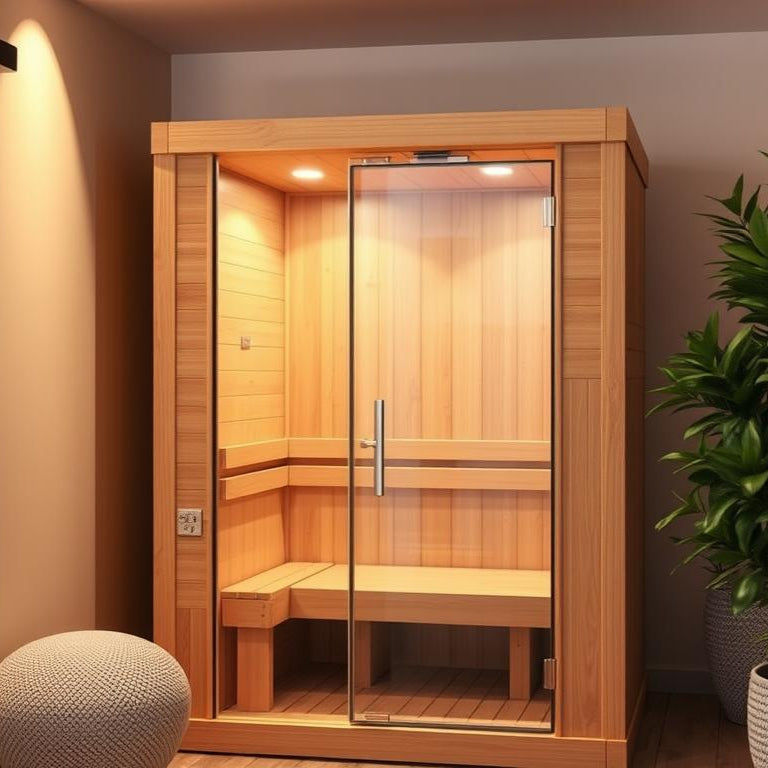
Unlock the Power of Sauna: 5 Key Benefits
Regular sauna use has been a cornerstone of wellness routines for centuries, offering a multitude of health benefits. From relaxation to detoxification, the advantages of incorporating sauna therapy into your lifestyle are numerous.
As we explore the world of sauna benefits, you'll discover how this simple practice can transform your health. Whether you're seeking to improve cardiovascular health or simply looking for a way to unwind, sauna therapy has something to offer.

Let's dive into the top 5 benefits that make sauna an integral part of a healthy lifestyle.
Key Takeaways
- Discover the cardiovascular advantages of regular sauna use
- Learn how sauna therapy can aid in detoxification
- Understand the role of sauna in stress relief and relaxation
- Explore the potential of sauna to improve athletic performance
- Find out how sauna can support weight loss efforts
The Ancient Practice of Sauna Bathing
Sauna culture, dating back thousands of years, has been a vital part of human wellness practices. The tradition of sauna bathing has its roots deeply embedded in history, with various cultures adopting and adapting it over time.
Historical Origins of Sauna Culture
The concept of sauna originated in Finland over 2,000 years ago, where it was not just a place for physical cleansing but also a spiritual sanctuary. The Finns believed that sauna was a place to connect with the divine and to purify both body and soul. Traditional sauna practices involved heating stones to produce steam, creating a warm, humid environment conducive to relaxation and detoxification.
Evolution of Sauna Practices Around the World
As cultures interacted and globalization took hold, sauna culture spread beyond Finland's borders. Different regions adapted sauna practices to their unique environments and cultural norms. For instance, in Japan, the concept of "sentō" emerged, incorporating elements of communal bathing and purification rituals. Similarly, in Turkey, "hamams" became popular, focusing on steam baths and social gatherings.
The history of sauna is a testament to its versatility and the universal human desire for relaxation and rejuvenation. Today, sauna practices continue to evolve, incorporating modern technology and wellness trends while retaining the essence of their ancient roots.
Different Types of Saunas Explained
Saunas have been a cornerstone of wellness routines for centuries, with various types catering to different needs and preferences. Whether you're a seasoned sauna enthusiast or just starting out, understanding the different options available can enhance your sauna experience.
Traditional Finnish Saunas
Traditional Finnish saunas are known for their dry heat, typically ranging between 150°F to 200°F. They offer numerous traditional sauna benefits, including detoxification through sweating and relaxation. The dry heat is ideal for those who enjoy a more authentic sauna experience.
Infrared Saunas
Infrared saunas, on the other hand, use infrared heaters to warm the body directly, rather than heating the air. This results in a more comfortable experience for some users and provides infrared sauna benefits such as deeper tissue penetration and potentially greater detoxification.
Steam Rooms vs. Dry Saunas
Steam rooms and dry saunas differ significantly in their approach to heat and humidity. While dry saunas maintain low humidity, steam rooms are characterized by high humidity levels, creating a distinctly different environment. Understanding these differences is key to choosing the right type of sauna for your needs.
In conclusion, the variety of saunas available means there's something for everyone. By exploring the different types of saunas, you can find the one that best suits your health and wellness goals.
How Saunas Work: The Science Behind the Heat
Saunas operate on a simple yet effective principle: exposing the body to high temperatures to induce various health benefits. This process involves a combination of factors, including temperature and humidity, which work together to create an environment that promotes detoxification, relaxation, and overall well-being.
Temperature and Humidity Factors
The temperature inside a sauna can range from 150°F to 200°F, while the humidity level is typically kept low. This combination of high heat and low humidity allows for efficient sweating, which is a key mechanism behind the detoxification process. The dry heat also helps to kill bacteria and other pathogens, contributing to a cleaner and healthier environment.
https://www.youtube.com/watch?v=TgdsFfGdDJA
How Your Body Responds to Sauna Heat
When you enter a sauna, your body responds to the heat by:
- Increasing heart rate and blood flow to the skin
- Inducing sweating to cool down
- Releasing toxins through the skin
- Relaxing muscles and reducing tension
This physiological response is not only beneficial for relaxation but also contributes to the various health benefits associated with sauna use, such as improved cardiovascular health and enhanced recovery.
Sauna Benefits: A Comprehensive Overview
Sauna use has been associated with numerous health benefits, ranging from improved cardiovascular health to enhanced mental wellbeing. Regular sauna bathing has been a cornerstone of health practices in various cultures, particularly in Nordic countries, for centuries.
Physical and Mental Health Advantages
The benefits of sauna use encompass both physical and mental health aspects. Physically, sauna use can lead to improved cardiovascular health, detoxification, and muscle relief. Mentally, it can reduce stress and improve overall mental wellbeing.
Short-term vs. Long-term Benefits
Sauna benefits can be categorized into short-term and long-term advantages. Short-term benefits include immediate relaxation and muscle relief, while long-term benefits encompass improved heart health and enhanced immune function.
| Benefits | Short-term | Long-term |
|---|---|---|
| Relaxation and Stress Relief | Immediate relaxation | Reduced chronic stress |
| Cardiovascular Health | Temporary improved circulation | Lower blood pressure, reduced heart disease risk |
| Mental Wellbeing | Improved mood | Enhanced mental health resilience |
As illustrated in the table, regular sauna use can lead to significant health improvements over time. Incorporating sauna bathing into your routine can be a valuable step towards achieving better overall health.
Benefit1: Improved Cardiovascular Health
Regular sauna use has been linked to numerous cardiovascular benefits, including improved heart health and reduced risk of heart disease. This practice has been a staple in Finnish culture for centuries, and recent research has begun to uncover the physiological mechanisms behind its health benefits.
Blood Pressure Regulation
One of the key cardiovascular benefits of sauna use is its effect on blood pressure regulation. Regular sauna bathing has been shown to help lower blood pressure in individuals with hypertension, reducing the risk of cardiovascular disease. The repeated exposure to heat stress during sauna use stimulates the body's natural vasodilation response, improving blood flow and reducing systemic vascular resistance.
Heart Health Research Findings
Research into the heart health benefits of sauna use has yielded promising results. Studies have found that frequent sauna bathing is associated with a reduced risk of cardiovascular mortality, including deaths from heart disease and stroke. The mechanisms behind this association are thought to include improved cardiovascular function, reduced inflammation, and enhanced autonomic nervous system function.
Studies on Sauna Use and Heart Disease Prevention
Several studies have investigated the relationship between sauna use and heart disease prevention. A notable study published in the Journal of the American College of Cardiology found that sauna bathing was associated with a reduced risk of fatal cardiovascular events. The table below summarizes some key findings from recent research:
| Study | Sample Size | Frequency of Sauna Use | Outcome |
|---|---|---|---|
| Laukkanen et al. (2015) | 2,315 men | 2-3 times per week | Reduced risk of cardiovascular mortality |
| Kunutsor et al. (2017) | 1,828 participants | Regular sauna use | Lower risk of heart disease and stroke |
| Lee et al. (2018) | 1,294 participants | Frequent sauna bathing | Improved cardiovascular function |
These findings highlight the potential of sauna use as a complementary strategy for maintaining cardiovascular health. By incorporating sauna bathing into their routine, individuals may be able to reduce their risk of heart disease and improve overall well-being.
Benefit2: Enhanced Recovery and Muscle Relief
The heat from saunas provides numerous benefits, including enhanced recovery and relief from muscle tension. This makes saunas an attractive recovery tool for athletes and individuals who engage in strenuous physical activities.
Post-Exercise Recovery Benefits
Sauna use after exercise has been shown to aid in recovery by improving circulation, reducing muscle soreness, and promoting the removal of metabolic waste products that build up during exercise. Improved circulation helps in delivering oxygen and nutrients to damaged muscles, thereby facilitating repair.
- Enhanced removal of metabolic waste
- Improved circulation for muscle repair
- Reduced muscle soreness
Muscle Tension Reduction
Saunas are also effective in reducing muscle tension. The heat therapy helps in relaxing muscles, reducing spasms, and improving flexibility. This is particularly beneficial for individuals with muscle injuries or those who experience chronic muscle tension.
How Heat Therapy Affects Muscle Tissue
Heat therapy, as provided by saunas, affects muscle tissue by increasing blood flow, reducing muscle spasms, and promoting relaxation. The increased temperature helps in reducing the viscosity of the blood, making it easier to circulate and supply oxygen and nutrients to the muscles.
The benefits of sauna use for muscle recovery and relief are backed by research. Regular sauna use can be a valuable addition to a fitness or training regimen, helping to improve performance and reduce recovery time.
Benefit3: Detoxification and Skin Health
The practice of sauna bathing is not only a relaxing ritual but also a potent tool for detoxifying the body and rejuvenating the skin. Regular sauna use has been associated with various health benefits, including enhanced detoxification processes and improved skin health.
One of the primary ways saunas contribute to detoxification is through sweating. When you spend time in a sauna, your body temperature rises, causing you to sweat profusely. This process helps eliminate toxins from the body, as sweat can carry out heavy metals and other harmful substances.
Sweating and Toxin Elimination
Sweating is a natural process that aids in removing toxins from the body. Saunas induce deep sweating, which can lead to the elimination of various toxins, including heavy metals like lead and mercury. This process is particularly beneficial for individuals exposed to environmental pollutants.
Key toxins eliminated through sweating:
- Heavy metals (lead, mercury)
- Environmental pollutants
- Chemical residues
Skin Cleansing and Rejuvenation
Sauna use not only aids in detoxification but also promotes skin health. The heat from the sauna opens up the pores, allowing for a deeper cleansing of the skin. This can lead to a reduction in acne and other skin issues.
Cellular Renewal Through Heat Exposure
The heat exposure from sauna use can stimulate cellular renewal processes. This can result in healthier, more youthful-looking skin. The heat shock proteins induced by sauna use can also contribute to the repair of damaged cells.
To illustrate the benefits of sauna use for skin health and detoxification, consider the following comparison:
| Benefit | Sauna Use | No Sauna Use |
|---|---|---|
| Detoxification through sweating | High | Low |
| Skin cleansing | Deep cleansing through opened pores | Limited to surface cleansing |
| Cellular renewal | Stimulated by heat shock proteins | Not stimulated |
In conclusion, incorporating sauna sessions into your wellness routine can have significant benefits for both detoxification and skin health. By promoting sweating, cleansing the skin, and stimulating cellular renewal, sauna use offers a holistic approach to improving overall health.
Benefit4: Stress Reduction and Mental Wellbeing
The mental wellbeing benefits of sauna use are multifaceted, offering a holistic approach to stress reduction. Regular sauna bathing has been linked to reduced symptoms of anxiety and depression, promoting overall mental health.
Sauna's Effect on Stress Hormones
Sauna use has been shown to decrease the production of stress hormones like cortisol. Regular sauna bathing can lead to a decrease in cortisol levels, contributing to a sense of calm and relaxation.
The heat from the sauna stimulates the release of certain neurotransmitters, such as endorphins, which are known to improve mood and reduce stress.
Mindfulness and Relaxation Aspects
The sauna environment encourages mindfulness and relaxation. By creating a peaceful atmosphere, saunas help individuals focus on the present moment, letting go of daily worries.
Many people find that the solitude of the sauna provides a much-needed break from the constant demands of modern life, allowing for mental rejuvenation.
Creating a Mental Health Ritual
Incorporating sauna use into your routine can be a powerful mental health ritual. Setting aside time to relax in the sauna can become a consistent practice that promotes mental wellbeing.
To maximize the benefits, consider combining sauna use with other relaxation techniques, such as deep breathing exercises or meditation.
By making sauna bathing a regular part of your self-care routine, you can harness its full potential for stress reduction and mental wellbeing.
Benefit5: Improved Sleep Quality
The connection between sauna bathing and enhanced sleep quality is gaining attention, with many finding it a valuable tool for a restful night's sleep. Regular sauna use has been linked to improved sleep in various studies, suggesting its potential as a non-pharmacological intervention for insomnia and other sleep disorders.
Temperature Regulation and Sleep Cycles
One of the key ways sauna bathing improves sleep quality is through its effect on the body's temperature regulation. Sauna use causes a significant rise in body temperature, followed by a drop after the sauna session, which can promote a deeper sleep. This temperature fluctuation mimics the body's natural temperature regulation during sleep cycles, potentially enhancing the quality of sleep.

Research on Sauna Use and Insomnia
Research has shown that regular sauna bathing can be beneficial for individuals suffering from insomnia. A study found that sauna bathing four to seven times a week reduced the risk of developing insomnia. The relaxing effect of sauna bathing can help reduce stress and anxiety, common underlying factors for sleep disturbances.
Creating an Optimal Pre-Sleep Routine
To maximize the sleep-enhancing benefits of sauna bathing, it's essential to incorporate it into a pre-sleep routine. Here are some tips:
- Sauna bathing should be done 1-2 hours before bedtime to allow the body temperature to drop.
- Avoid using electronic devices after sauna bathing to minimize blue light exposure.
- Maintain a consistent sleep schedule to regulate the body's internal clock.
| Pre-Sleep Routine | Benefits |
|---|---|
| Sauna Bathing | Relaxation, Temperature Regulation |
| No Electronic Devices | Reduced Blue Light Exposure |
| Consistent Sleep Schedule | Regulated Body Clock |
By incorporating sauna bathing into a pre-sleep routine and maintaining good sleep hygiene practices, individuals can potentially improve their sleep quality. This holistic approach to sleep health underscores the multifaceted benefits of sauna bathing.
Sauna Safety: Best Practices and Precautions
To fully reap the rewards of sauna use, understanding and adhering to safety precautions is essential. While saunas are generally safe for most people, there are certain guidelines to follow to ensure a safe and enjoyable experience.
Who Should Avoid Sauna Use
Certain individuals should exercise caution or avoid sauna use altogether. This includes people with specific health conditions such as heart problems, high blood pressure, or pregnant women. It's also advisable for individuals with certain medical implants or those taking particular medications to consult their healthcare provider before using a sauna.
Duration and Frequency Guidelines
To enjoy sauna benefits while minimizing risks, follow these guidelines:
- Sessions should typically last between 15 to 20 minutes.
- Beginners should start with shorter sessions and gradually increase duration as they acclimate.
- Limit sauna use to 2-3 times a week to avoid overstraining your body.
- Always stay hydrated by drinking water before, during, and after sauna use.
By being mindful of these guidelines and taking necessary precautions, you can safely enjoy the many benefits that sauna bathing has to offer.
Incorporating Sauna Into Your Wellness Routine
To maximize the benefits of sauna bathing, it's essential to integrate it thoughtfully into your wellness routine. Consistency is key to experiencing the full range of physical and mental health benefits that sauna use has to offer.
Creating a Sustainable Sauna Schedule
Developing a sauna schedule that works for you is crucial. Aim for 2-3 sessions per week, with each session lasting around 15-20 minutes. Listen to your body and adjust the frequency and duration based on how you feel.
Combining Sauna With Other Health Practices
Sauna can be effectively combined with other health practices such as meditation, yoga, or a healthy diet to enhance overall wellbeing. For example, using a sauna after a workout can aid in recovery, while combining it with meditation can amplify stress relief benefits.
Conclusion: Embracing the Sauna Lifestyle
As we've explored throughout this article, incorporating sauna into your daily routine can have a significant impact on your overall wellbeing. By embracing the sauna lifestyle, you can experience the numerous benefits that sauna use has to offer, from improved cardiovascular health to enhanced mental wellbeing.
Adopting a sauna lifestyle is not just about spending time in the heat; it's about cultivating a holistic approach to health. Regular sauna use can become a therapeutic ritual that promotes relaxation, reduces stress, and rejuvenates both body and mind. By making sauna a part of your wellness routine, you can take a proactive step towards embracing sauna benefits and improving your overall quality of life.
Whether you're looking to enhance your physical health, mental wellbeing, or simply seeking a moment of tranquility, the sauna lifestyle offers a unique opportunity to invest in your overall wellbeing. So why not start embracing the sauna lifestyle today and discover the transformative power of sauna for yourself?
FAQ
What are the benefits of using an infrared sauna compared to a traditional Finnish sauna?
Infrared saunas use infrared heaters to warm the body directly, whereas traditional Finnish saunas rely on steam and high temperatures. Infrared saunas are often considered more comfortable and may be beneficial for those who are sensitive to high heat.
How often should I use a sauna for optimal benefits?
The frequency of sauna use depends on individual goals and health status. For general wellness, 2-3 times a week is a good starting point. For specific benefits like cardiovascular health or muscle recovery, more frequent use may be beneficial.
Can sauna use help with detoxification and skin health?
Yes, sauna use can aid in detoxification through sweating, which helps eliminate toxins from the body. Regular sauna use can also improve skin health by promoting cleansing and rejuvenation.
Is it safe to use a sauna if I have a medical condition?
It depends on the condition. Certain conditions, such as high blood pressure or heart problems, may require caution or consultation with a healthcare provider before using a sauna. Pregnant women and people with certain medical implants should also consult their doctor.
How long should I stay in a sauna session?
Beginners should start with shorter sessions (15-20 minutes) and gradually increase duration as they acclimate. Generally, sessions can range from 20 to 45 minutes, but it's essential to listen to your body and exit if you feel uncomfortable.
Can sauna use improve mental health and reduce stress?
Yes, sauna use has been linked to reduced stress levels and improved mental wellbeing. The relaxing environment and heat therapy can help reduce stress hormones and promote a sense of calm.
How can I incorporate sauna into my pre-sleep routine for better sleep quality?
Using a sauna 1-2 hours before bedtime can help regulate body temperature, promoting a restful sleep. It's also essential to maintain a consistent sleep schedule and create a relaxing bedtime routine.
Are there any specific guidelines for sauna use in combination with exercise or physical activity?
Sauna use can be beneficial after exercise for recovery. It's recommended to wait at least 30 minutes after exercise before using a sauna to allow for rehydration and to avoid dehydration.







Leave a comment
This site is protected by hCaptcha and the hCaptcha Privacy Policy and Terms of Service apply.